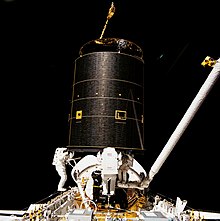Intelsat 603
| Intelsat 603 | |
|---|---|
| Start date | March 14, 1990 |
| Launcher | Titan III 154 |
| Launch site | LC-40 , Cape Canaveral , Florida |
| COSPAR-ID : | 1990-021A |
| Takeoff mass | 4300 kg |
| Mass in orbit | 2560 kg |
| Manufacturer | Hughes Space and Communications (today: Boeing Satellite Systems ) |
| model | HS-389 |
| lifespan | ten years |
| Stabilization | Spin |
| operator | Intelsat |
| Playback information | |
| Transponder | 38 C-band + 12 backup 10 Ku-band + 4 backup |
| Transponder performance | C-band 6 × 16 W + 32 × 10 W Ku-band 8 × 20 W + 2 × 40 W. |
| Bandwidth | C-band 36, 41 and 72 MHz 8 × 72 and 2 × 150 MHz |
| EIRP | C-Band Global Beam 29 dBW C-Band Hemi Beam 36 dBW C-Band Zone Beam 38 dBW Ku-Band Spot Europe West 52 dBW Ku-Band Spot Southeast Europe 52 dBW |
| Others | |
| Electrical power | Start: 2600 W |
| position | |
| First position | 34.5 ° west |
| Actual position | 11.5 ° East |
| List of geostationary satellites | |
Intelsat 603 was a communications satellite from the Luxembourg technology company Intelsat . The satellite was the third of five Intelsat VI series and, like the others, was cylindrical in shape, 3.65 m in diameter and 5.33 m high.
The launch on 14 March 1990 at the head of a rocket of the type Titan 3 (titanium flight number 154) failed, as the second stage did not separate from the satellite. In order to prevent re-entry into the earth's atmosphere and prevent the Intelsat from burning up, the engines of the satellite itself were used. This allowed it to be brought to a low orbit of about 370.4 km (200 nautical miles ).
The failure was corrected as part of the space shuttle mission STS-49 , which was launched on May 7, 1992 : On May 13, 1992 the space shuttle Endeavor maneuvered itself near the wrecked satellite. The catching of the 4,215 kg Intelsat was only successful on the third attempt and made field trips necessary for the space travelers with a total duration of over 17 hours.
With a new motor, the satellite was able to move to a geostationary position at 34.5 ° W. In October 1997 it was repositioned to 24.5 ° W, where it remained until August 2002. Then Intelsat was placed in an inclined orbit , first at 19.95 ° West, from May 2010 on 11.5 ° East.
In January 2013, the transponders were switched off and the Intelsat 603 was placed in a cemetery orbit over the previous orbit. The satellite was finally switched off on January 23, 2015.
reception
The transmission took place in the C and Ku bands , the satellite could be received in Europe , Africa , North and South America and the Middle East .
Web links
- YouTube video of the repair mission (English)
Individual evidence
- ↑ Jean-Philippe Donnio: Intelsat 603. In: The Satellite Encyclopedia. May 28, 2017, accessed July 5, 2017 .
- ↑ Collin Skocik: Looking back as Intelsat 603 mission ends in satellite “graveyard”. SpaceFlight Insider, February 26, 2015, accessed July 5, 2017 .
